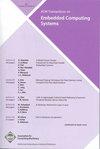基于近场电磁测量的高精度指令拆卸分层分类方法
IF 2.8
3区 计算机科学
Q2 COMPUTER SCIENCE, HARDWARE & ARCHITECTURE
引用次数: 1
摘要
电磁(EM)场作为测试硬件实现安全性的有效侧信道工具已被广泛研究。在这项工作中,提出了一种低成本的侧信道反汇编器,它使用细粒度的EM信号来高精度地预测程序的执行轨迹。与传统的侧通道反汇编器不同,所提出的反汇编器不需要大量的随机指令实例来分析它们,而是依赖于由指令执行产生的泄漏模型通知的潜在架构状态的子采样,通过使用结构化分层方法进一步增强了这一点。所提出的反汇编器包括两个阶段:(i)在特征选择阶段,在执行分析代码时,用相对较小的EM探针收集信号,在芯片表面附近进行高分辨率扫描。通过存储探测电磁场的最小-最大包络和由此产生的差分信号,来自多种探头配置的测量信号被编译成一个分层数据库,这是一个新的维度,增加了分析的效力。在整个层次结构中评估信封到信封的距离,以确定使每对指令类之间的距离最大化的最佳测量配置。(ii)在分类阶段,使用第一阶段确定的最优测量配置对未知指令测量的信号与数据库中存储的信封进行比较,进行多数投票的二值分类,确定每个层次阶段的候选指令类。反汇编器的两个阶段都依赖于按长度、大小、操作数和功能对指令进行的4阶段分层分组。所提出的反汇编器被证明可以从AT89S51微控制器上执行的几个测试和应用基准程序中恢复~ 97-99%的指令。本文章由计算机程序翻译,如有差异,请以英文原文为准。
A Hierarchical Classification Method for High-Accuracy Instruction Disassembly with Near-Field EM Measurements
Electromagnetic (EM) fields have been extensively studied as potent side-channel tools for testing the security of hardware implementations. In this work, a low-cost side-channel disassembler that uses fine-grained EM signals to predict a program's execution trace with high accuracy is proposed. Unlike conventional side-channel disassemblers, the proposed disassembler does not require extensive randomized instantiations of instructions to profile them, instead relying on leakage-model-informed sub-sampling of potential architectural states resulting from instruction execution, which is further augmented by using a structured hierarchical approach. The proposed disassembler consists of two phases: (i) In the feature-selection phase, signals are collected with a relatively small EM probe, performing high-resolution scans near the chip surface, as profiling codes are executed. The measured signals from the numerous probe configurations are compiled into a hierarchical database by storing the min-max envelopes of the probed EM fields and differential signals derived from them, a novel dimension that increases the potency of the analysis. The envelope-to-envelope distances are evaluated throughout the hierarchy to identify optimal measurement configurations that maximize the distance between each pair of instruction classes. (ii) In the classification phase, signals measured for unknown instructions using optimal measurement configurations identified in the first phase are compared to the envelopes stored in the database to perform binary classification with majority voting, identifying candidate instruction classes at each hierarchical stage. Both phases of the disassembler rely on a 4-stage hierarchical grouping of instructions by their length, size, operands, and functions. The proposed disassembler is shown to recover ∼97-99% of instructions from several test and application benchmark programs executed on the AT89S51 microcontroller.
求助全文
通过发布文献求助,成功后即可免费获取论文全文。
去求助
来源期刊

ACM Transactions on Embedded Computing Systems
工程技术-计算机:软件工程
CiteScore
3.70
自引率
0.00%
发文量
138
审稿时长
6 months
期刊介绍:
The design of embedded computing systems, both the software and hardware, increasingly relies on sophisticated algorithms, analytical models, and methodologies. ACM Transactions on Embedded Computing Systems (TECS) aims to present the leading work relating to the analysis, design, behavior, and experience with embedded computing systems.
 求助内容:
求助内容: 应助结果提醒方式:
应助结果提醒方式:


